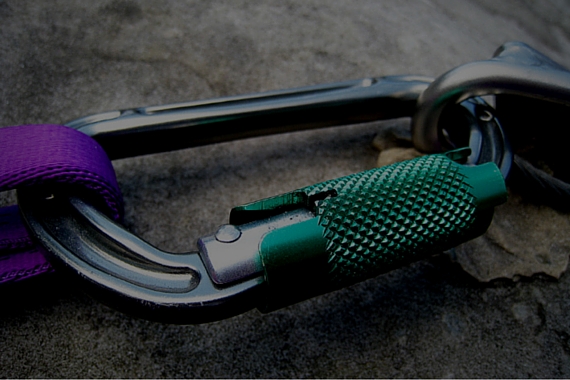
This is part 2 of a 3-part university study, conducted to assess carabiner strength and testing methods. Part 1 provides background into the study and addresses prior research, part 2 covers metal gear experimentation and results, and part 3 will explore webbing gear testing approaches and strength.
Breaking carabiners test preparation:
With my initial set of background questions answered (see Part 1 of this Carabiner study), I began to formulate my test method as I machined my carabiner testing fixtures. While I was working on my fixtures I also began accumulating old carabiners of all shapes and sizes. I contacted local Search & Rescue groups, climbing gyms, dirtbag friends, and even went as far as taking the oldest and most beat up ‘biners from my own rack—which at the time was rather pathetic amalgamation of new and used gear.
Related: Climbing Gear of the Past
The carabiners I was most interested in collecting were those that were extremely rope-worn. Having had climbed for a number of years up to that point, I found that some of my oldest and most heavily used pieces were suffering from wear where the rope abraded constantly in the same place.
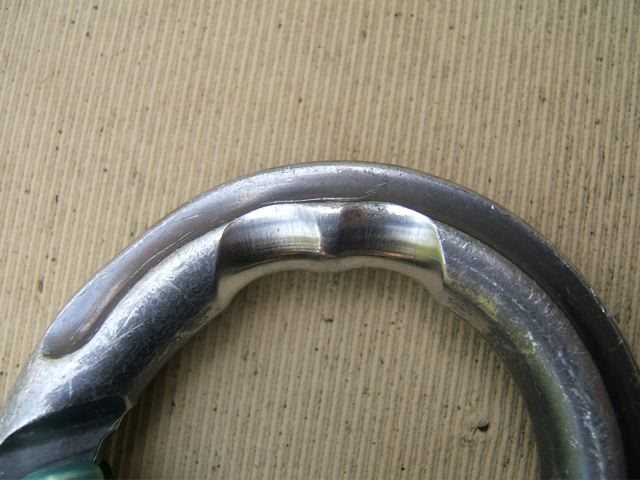
Rope abrasion
The state of my belay carabiner was especially shocking! Such an integral piece of gear as a belay biner should (ideally) be in perfect condition; the excess wear got me wondering if the loss of metal could compromise the strength of the piece. Not to mention the sometime sharp edge that can be produced as a result of extreme rope wear.
So, I sat down at the Instron machine with my box of old carabiners and I began to design my test.
The two main questions I wanted answers to:
- Does a carabiner really break at the load (kN) printed on the spine?
- How significantly (if at all) does moderate rope-wear effect the breaking strength of a carabiner?
Machine setup
To answer these questions, testing was conducted using the Cal Poly Mechanical Engineering Department’s Instron model 1331 that has a 100 kN (11 tons) capacity—which is like, Adam Ondra strong!
The procedure used for breaking a carabiner basically involved loading the carabiner into the fixtures I made, clamping the fixtures into the machine, dialing a few settings, pressing record on a chart (which measured applied strength of the machine on the carabiner versus elongation of the carabiner as it stretched under the given load), and pressing ‘start’ to watch the breakage!
Results
Non-locking carabiners tested:
Testing began on an assortment of non-locking carabiners all with either wire or solid gates (bent, straight, or key). The first carabiner tested was a new Black Diamond Posiwire. The Posiwire is D-shaped, has a key gate, and has closed gate rating of 25 kN and an open gate rating of 8 kN.
The results from the Single Pull To Failure test (that is the official term for pulling on a ‘biner until it explodes) can be seen in the figure below.
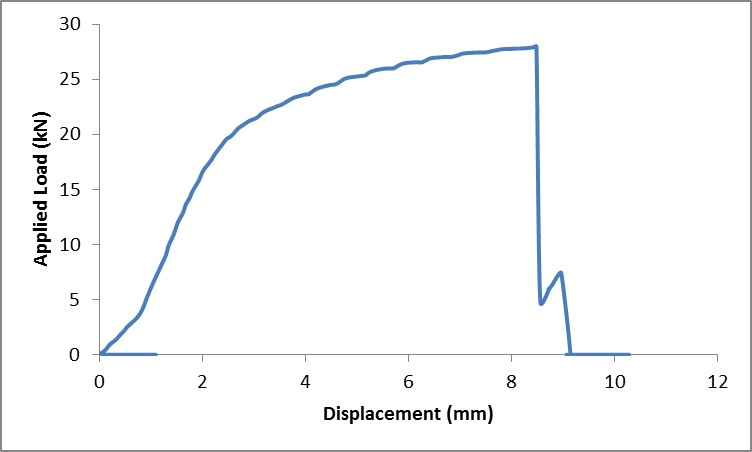
Half Dome, is that you?! Load vs. displacement curve for a new Black Diamond key gate carabiner initially closed and put through a Single Pull To Failure test. Highest peak represents failure of gate at 27.9kN; second, small peak on the right represents spine failure at 7.4kN after broken gate.
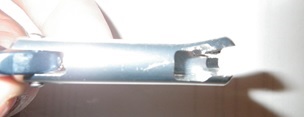
Gate blown carabiner
The linearity of the curve from 0 to 23 kN approximately represents the elastic deformation region of the closed carabiner. Above this range lies the plastic deformation region (where metal has stopped bending and is actually stretching like silly putty).
Failure first occurred at 27.9 kN when the gate exploded, and the spine of the carabiner failed at 7.4 kN. These results show an 11% increase from the printed closed gate rating on the carabiner and an 8% reduction in strength from the open gate rating. This trend was common for all tests done of this type, and shall be explained in detail later in the conclusion section.
Conclusions for non-locking carabiners
When testing non-locking carabiners, two things were generally observed to be constant from every test based on gate type:
- For non-locking wire gate carabiners, failure would typically occur the base of the spine with no initial failure at the gate.
- For non-locking key gate carabiners, the carabiner would fail at the end of the gate due to bending of the key hole.
Granted the rate of pull of the machine, testing was conducted slowly such that the loads could be considered static. This applied static load would first break the gate (for new carabiners, failure always occurred at a load greater than the closed gate rating), and the load would increase until the carabiner would fail at the spine around the open gate rating of the carabiner.
Almost always, the open gate rating would be greater than the applied load to open gate failure. It is important to take note of this discrepancy as it appeared frequently. This is most likely due to the fact that as the carabiner begins to deform before initial failure, it deforms past the point of elastic deformation and begins to permanently deform shortly before failing at the gate. When the gate fails, the plastic deformation serves to weaken the spine such that it breaks at a lesser value than the open gate rating specifies.
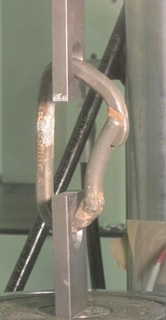
Corroded carabiner
Given this hypothesis, it cannot be considered valid to extract two results from one SPTF test in order to compare both the open gate rating and the closed gate rating. Thus, for every test conducted, only the ultimate strength of the closed-gate test could be considered valid.
As an aside to testing the reduction in strength of a carabiner due to rope wear, one particularly interesting test was conducted on a severely corroded bent gate carabiner found on a canyoneering trip in Death Valley. The carabiner was found half buried in dirt and at the time of discovery would not open. With a little cleaning and some oil, it eventually opened and was subsequently used for clipping gear to a backpack before being donated for testing. No amount of cleaning could hide the thick layer of aluminum oxide penetrating the surface of the spine. This Omegalite 3 ‘biner had a closed gate rating of 25 kN and failed at merely 16 kN (still approximately 3,600 lbs)!
Related: Rock Climbing Science: Understanding Friction Forces
Locking carabiners tested:
For locking carabiners, testing was conducted on both new carabiners and old rope-worn carabiners. The hypothesis was that rope worn carabiners would have a significant reduction in strength over their new counterparts, due to the fact that the reduced cross sectional area of the rope worn area would significantly reduce the strength of the carabiner by creating stress concentration in that area. This is the same principle that explains the ease of breaking a wishbone.
Available for the test were two auto-locking belay carabiners, both with approximately 3 mm deep grooves from regular use belaying (see Figure 8). These two carabiners had a closed gate rating of 24 kN and an open gate rating of 8 kN. Both rope worn carabiners responded similarly to the SPTF test and failed within 0.5 kN of each other. The results of the test in graphical form are as follows.
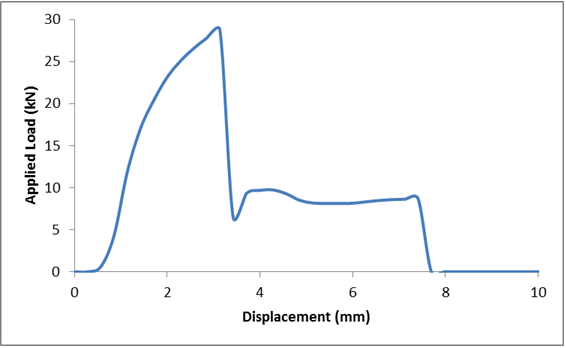
Results of tensile test for locking carabiners. You can see that the distance stretched (displacement) was much greater here than on the non-locking carabiners. Also, the breaking strength of the closed-gate locking carabiner was much higher!
Up next in Part 3, results of tests conducted on textile gear, such as quickdraw dogbones and slings—new and old—will be explored.
Now to you
What do you think? Have you ever experienced gear failure? Had fears about the gear your life relies on? Share your experiences or general questions in the comments below.

